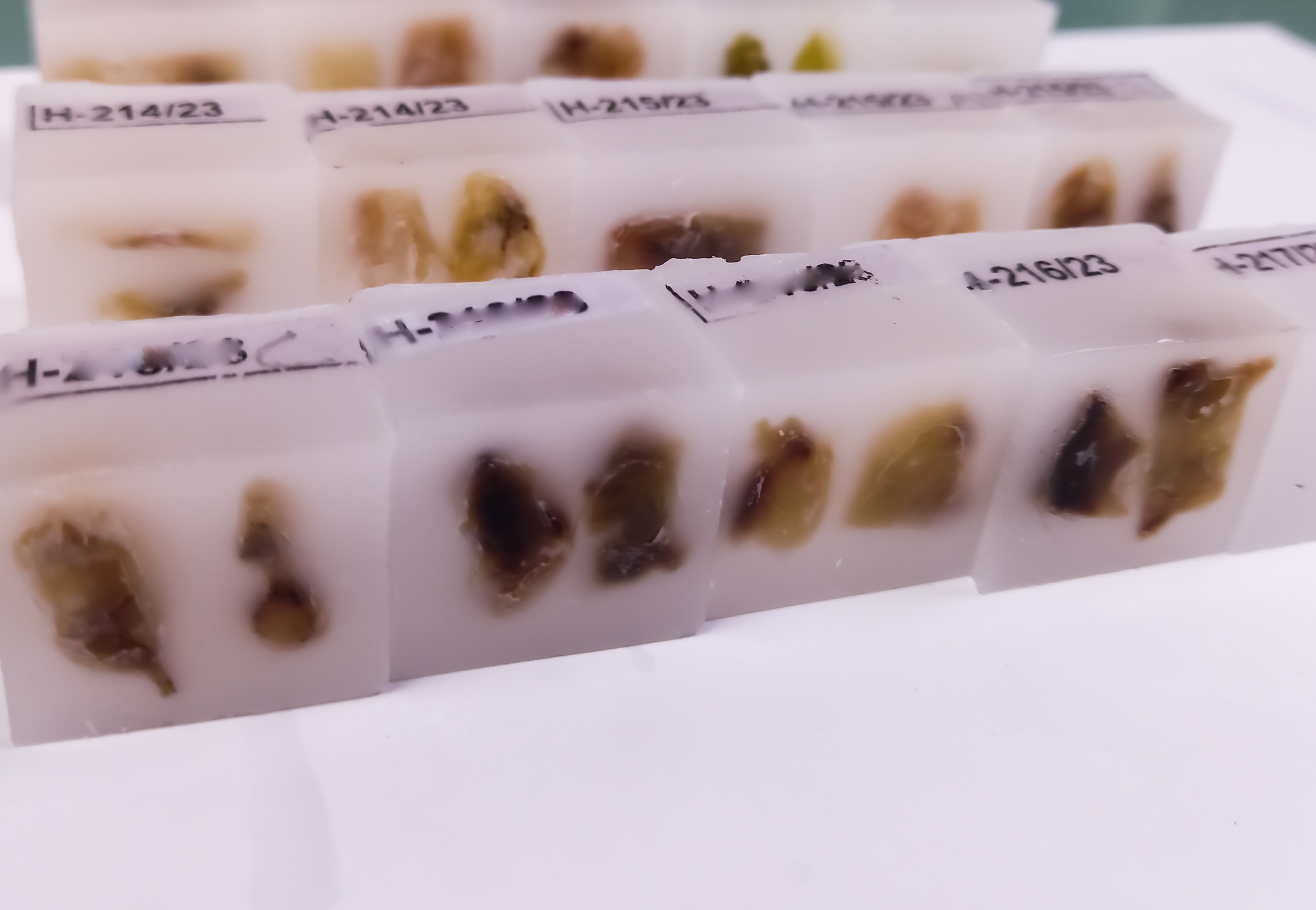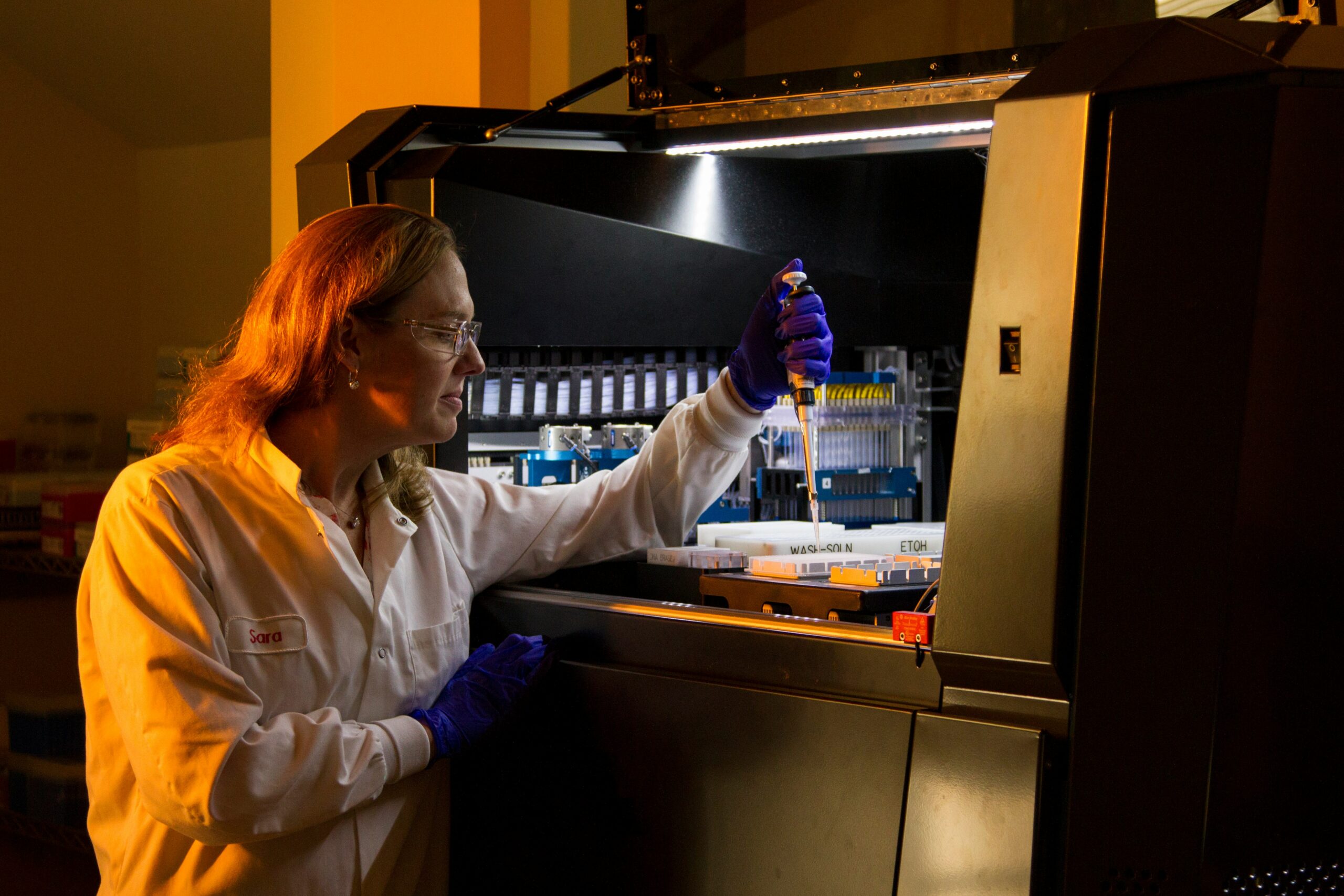Significance of FFPE Tissue Samples in Preventive Genomics and Precision Medicine

Formalin-fixed paraffin-embedded (FFPE) tissues can play a transformative role in preventive genomics and precision medicine. Analysis of DNA and RNA are central to our understanding of disease and disease risk. With FFPE tissues, these biomolecules (and other essential characteristics) are available for scientists to study. The longevity of FFPE tissue samples and their long history of use means there is a vast archive of biospecimens for researchers and clinicians to gain crucial insights from. Here, we will discuss the potential of FFPE tissues in precision medicine and preventive genomics and how advances in biobanking practices enhance the utility of FFPE tissues in research and clinical contexts.
Understanding FFPE Tissues
FFPE tissues have been collected since the nineteenth century, and today, millions of FFPE tissue samples are stored and available for analysis1. Formalin is a formaldehyde solution used to fix the sample, preserving tissue architecture and the integrity of constituent biomolecules like DNA, RNA, and protein. Paraffin wax has a wide variety of applications, including its use in FFPE tissue preservation, offering greater sample protection compared to other techniques like freezing and with the reduced cost of ambient storage. FFPE tissues can be stored as FFPE blocks for decades, giving them enduring value in medical research by providing biospecimens with many biomolecules for potential analysis.
The Importance of Biospecimen for Medical Research
Biospecimen procurement is central to diagnostics but also for research by allowing researchers to study diseased tissue and provide a starting point for drug discovery. With the increasing power of sequencing, storage, and biobanking in healthcare, biospecimen analysis leads to even greater insights at the individual and population levels. Indeed, biospecimen procurement is what makes population genetics and precision medicine possible in the first place. Effective biospecimen procurement and storage expedites drug discovery and greatly enriches disease research efforts, especially in emerging areas like preventive genomics.
What is Preventive Genomics?
Preventive genomics is the process of using genetic information to predict the future occurrence of disease, giving patients the opportunity to take preventative measures. Genetic variants can predispose individuals to many diseases, such as cancer. Breast cancer type 1 susceptibility protein (BRCA1) and BRCA2 gene mutations are well-known examples of genetic predisposition to disease and are linked with a higher risk of developing breast and ovarian cancer. Screening for these mutations, before cancer develops, enables patients and clinicians to act preemptively to prevent this disease.
Such actions could include more regular screening to detect the disease early. Technological advances have allowed us to study polygenic conditions with more subtle genetic influences such as alcoholism2, depression3, and obesity4. The more insights we obtain from genomic studies, the greater ability we have to prevent disease development and tailor treatments to specific patients through precision medicine.
The New Precision Medicine
Precision medicine continues to transform the therapeutic landscape for many diseases, including cancer. For example, recent techniques such as patient-derived cancer organoids allow researchers to model patient-specific tumors and even test treatment efficacy to help inform clinical decision-making5. Clinical research has also adapted to emerging personalized therapies with the introduction of N-of-1 clinical trials and increased focus on tailoring trials to individual patients6. Trials such as the I-SPY (Investigation of Serial Studies to Predict Your Therapeutic Response With Imaging And Molecular Analysis) aim to evaluate multiple targeted therapies simultaneously, expediting the regulatory process compared to traditional clinical trial structures7. Furthermore, precision medicines have a higher chance of succeeding in clinical trials than conventional therapies, thereby offering greater chances to benefit patients.

The Role of FFPE Tissues in Medical Research
FFPE human tissue samples offer a wealth of information for studying disease development, progression, and treatment efficacy by providing relevant biomolecules and structural information for analysis.
Disease Development
Disease Progression
The progression of diseases is generally associated with changes in gene expression and morphology. Indeed, morphology and immunohistochemistry (IHC) staining using FFPE slides can be used to track the differentiation or dedifferentiation of cell types which is synonymous with many diseases like cancer.
Treatment Efficacy
Many diseases lead to disruption of tissue architecture such as inflammatory diseases like Crohn’s disease and cancer; thus, treatment efficacy can be tracked using IHC. DNA and RNA from FFPE tissues allow clinicians to answer important questions such as:
- “Why did this treatment work for this patient and not another?”
- “Why did the patient develop resistance after two months?”
- ”What mutations or transcriptome changes were associated with that resistance?”
FFPE slides for IHC allow clinicians to monitor immune cell infiltration which is important for treatment efficacy in cancer.

Preventive Genomics and Precision Medicine
FFPE samples offer key insights into genomic susceptibility by providing DNA for analysis. Recent technological advances allow for archived FFPE tissue samples to be analyzed. Thus, an increasing number of individuals will have access to insights on their genetic susceptibility to different diseases. FFPE samples have huge potential to increase the reach of preventive genomics and allow the benefits of precision medicine to reach more patients.
Challenges and Innovation in FFPE Biobanking
Despite the utility of FFPE samples in biobanking, some challenges prevent the realization of its full potential. Recent technological advancements in extraction methods have allowed some of these barriers to be overcome.
Collection and Storage
A major challenge associated with utilizing FFPE tissue biosamples is the lack of standardized protocols. This means that the precise reagents used for the fixing and embedding process are different between samples. Different processing methods and storage conditions lead to significant differences in results which is well supported by the literature10. The lack of standardization makes it difficult to coordinate sample exchange or to compare data generated across different biobanks.
These limitations impede research efforts and emphasize the need for standardized procedures. The standardized preanalytical code (SPREC) system offers a solution to this problem by ensuring that all relevant information about sample storage and processing is recorded and readily available.
Sample Utilization
FFPE techniques are effective at storing and preserving tissue, however, they introduce chemical alteration in DNA samples over time which provides a barrier to its use for analysis. These alterations include base modification, base excision, covalent cross-linkage, cytosine deamination, and polydeoxyribose fragmentation1. Similar challenges are faced with RNA from FFPE which is an inherently more fragile molecule than DNA11.
However, there has been a lot of progress made in improving the quality of extracted biomolecules and minimal reporting requirements for processing which help with inter-study comparisons. Indeed recent studies showed extraction methods can enhance the usability of DNA12,13 and RNA14 extracted from FFPE blocks. These innovations greatly improve the ability of FFPE samples in biobanks to provide insights into various diseases.
Clinical Applications and Case Studies
FFPE tissues have been used in many pre-clinical and clinical research applications. FFPE tissues were used to determine a 70 gene signature in breast cancer which allowed clinicians to determine if patients could forgo conventional chemotherapy treatments. Based on the results of the clinical trial, researchers concluded that nearly half of women who were categorized as having “high clinical risk” may not have required chemotherapy. This insight increased the personalization of the treatment regimen, meaning that individuals did not need harmful, side-effect-heavy treatments15.
In another clinical trial, FFPE tissues were used to track the efficacy of anaplastic lymphoma kinase inhibition in non-small-cell lung cancer16. The availability of FFPE tissues allowed for fluorescence in-situ hybridization and RT-PCR studies to be performed on the same samples, which is not possible with other tissue preservation techniques. The treatment was ultimately effective in shrinking tumors and stopping tumor growth.
These two case studies provide excellent evidence of the utility of FFPE blocks in advancing preventive genomics and personalized healthcare. Indeed, in the latter study, researchers were able to detect the abundance of a fusion protein that is known to cause diseases and may have utility in preventive genomics. The first study demonstrates how genomic material sourced from FFPE human tissue samples can be used to tailor treatments for better patient outcomes15.
The Future of FFPE Tissue Samples in Personalized Healthcare
FFPE tissue samples are set to play a major role in the future of personalized healthcare. Large datasets that target cancer like The Cancer Genome Atlas, and the International Cancer Genome Consortium provide a large amount of genetic information on different cancers. Improvements in extracting usable material from FFPE samples and analyzing the resultant data mean that a huge archive of samples will be added to the global pool of biospecimens for analysis.
FFPE provides several benefits over other methods of tissue preservation. FFPE blocks preserve DNA, RNA, protein, and tissue microanatomy. This means that FFPE tissues can be a source material for virtually any bioanalytical method we have at our disposal from next-generation whole genome sequencing14, to single-nucleus RNA sequencing17, and of course, IHC. Therefore, FFPE human tissue samples greatly enrich the types of data available from biobanks.
Conclusion
FFPE tissue samples provide a wealth of information on different aspects of disease biology from disease progression to therapy response. Advances in FFPE processing, storage, and biobanking mean that the fields of personalized medicine and preventive genomics will see significant growth soon, with the outcome of better treatment regimens for patients suffering from diseases.
Visit our dedicated product page to discover more about how FFPE samples can enhance your research. Get in touch with one of our experts today to request a personalized quote.
References
- Steiert TA, Parra G, Gut M, et al. A critical spotlight on the paradigms of FFPE-DNA sequencing. Nucleic Acids Res. 2023;51(14):7143-7162. doi:10.1093/nar/gkad519
- Agrawal A, Brislin SJ, Bucholz KK, et al. The Collaborative Study on the Genetics of Alcoholism: Overview. Genes Brain Behav. 2023;22(5):e12864. doi:10.1111/gbb.12864
- Kwong ASF, Morris TT, Pearson RM, et al. Polygenic risk for depression, anxiety and neuroticism are associated with the severity and rate of change in depressive symptoms across adolescence. J Child Psychol Psychiatry. 2021;62(12):1462-1474. doi:10.1111/jcpp.13422
- Choe EK, Shivakumar M, Lee SM, Verma A, Kim D. Dissecting the clinical relevance of polygenic risk score for obesity-a cross-sectional, longitudinal analysis. Int J Obes 2005. 2022;46(9):1686-1693. doi:10.1038/s41366-022-01168-2
- LeSavage BL, Suhar RA, Broguiere N, Lutolf MP, Heilshorn SC. Next-generation cancer organoids. Nat Mater. 2022;21(2):143-159. doi:10.1038/s41563-021-01057-5
- Fountzilas E, Tsimberidou AM, Vo HH, Kurzrock R. Clinical trial design in the era of precision medicine. Genome Med. 2022;14(1):101. doi:10.1186/s13073-022-01102-1
- Das S, Lo AW. Re-inventing drug development: A case study of the I-SPY 2 breast cancer clinical trials program. Contemp Clin Trials. 2017;62:168-174. doi:10.1016/j.cct.2017.09.002
- Navin NE, Hicks J. Tracing the tumor lineage. Mol Oncol. 2010;4(3):267-283. doi:10.1016/j.molonc.2010.04.010
- Sun Q, Lee W, Mohri Y, et al. A novel mouse model demonstrates that oncogenic melanocyte stem cells engender melanoma resembling human disease. Nat Commun. 2019;10(1):5023. doi:10.1038/s41467-019-12733-1
- Turashvili G, Yang W, McKinney S, et al. Nucleic acid quantity and quality from paraffin blocks: defining optimal fixation, processing and DNA/RNA extraction techniques. Exp Mol Pathol. 2012;92(1):33-43. doi:10.1016/j.yexmp.2011.09.013
- Kong H, Zhu M, Cui F, et al. Quantitative assessment of short amplicons in FFPE-derived long-chain RNA. Sci Rep. 2014;4(1):7246. doi:10.1038/srep07246
- Guo Q, Lakatos E, Bakir IA, Curtius K, Graham TA, Mustonen V. The mutational signatures of formalin fixation on the human genome. Nat Commun. 2022;13(1):4487. doi:10.1038/s41467-022-32041-5
- Martelotto LG, Baslan T, Kendall J, et al. Whole-genome single-cell copy number profiling from formalin-fixed paraffin-embedded samples. Nat Med. 2017;23(3):376-385. doi:10.1038/nm.4279
- Newton Y, Sedgewick AJ, Cisneros L, et al. Large scale, robust, and accurate whole transcriptome profiling from clinical formalin-fixed paraffin-embedded samples. Sci Rep. 2020;10(1):17597. doi:10.1038/s41598-020-74483-1
- Cardoso F, Van’T Veer LJ, Bogaerts J, et al. 70-Gene Signature as an Aid to Treatment Decisions in Early-Stage Breast Cancer. N Engl J Med. 2016;375(8):717-729. doi:10.1056/NEJMoa1602253
- Kwak EL, Bang YJ, Camidge DR, et al. Anaplastic Lymphoma Kinase Inhibition in Non–Small-Cell Lung Cancer. N Engl J Med. 2010;363(18):1693-1703. doi:10.1056/NEJMoa1006448
- Xu Z, Zhang T, Chen H, et al. High-throughput single nucleus total RNA sequencing of formalin-fixed paraffin-embedded tissues by snRandom-seq. Nat Commun. 2023;14(1):2734. doi:10.1038/s41467-023-38409-5

